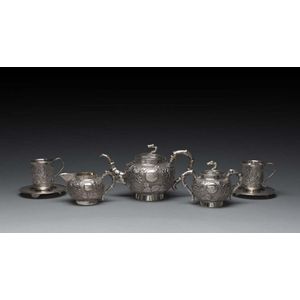Art Deco Walnut Cabinet with Carved Details
You must be a subscriber, and be logged in to view price and dealer details.
Subscribe Now to view actual auction price for this item
When you subscribe, you have the option of setting the currency in which to display prices to $Au, $US, $NZ or Stg.
- Circa - A Latin term meaning 'about', often used in the antique trade to give an approximate date for the piece, usually considered to be five years on either side of the circa year. Thus, circa 1900 means the piece was made about 1900, probably between 1895 and 1905. The expression is sometimes abbreviated to c.1900.
- Faux - A French word meaning "false", but when used in decorative arts, the intention is not to deceive, but to simulate the decorative effects of the more expensive material it is imitating. The term " faux bois" meaning "false wood" refers to a furniture item that has been decorated with a marked grain (woodgrain finish) to imitate a more expensive timber.
- Bevel / Chamfer - In furniture making, a chamfered corner refers to a technique used to create a smooth, angled edge on the corner of a piece of furniture. This is typically done by cutting away a small portion of the corner at an angle, typically 45 degrees, creating a diagonal edge, rather than a sharp 90-degree angle. This technique can be used on various parts of a piece of furniture such as table legs, drawer fronts, or door frames. Chamfering can add visual interest to a piece and can help to soften the overall look of a piece of furniture. It is often used in conjunction with other techniques, such as rounding edges or using contrasting wood species to create a more elegant, sophisticated look. Chamfering is a simple way to add a touch of elegance to a piece of furniture and it is a common technique used by furniture makers.
- Art Deco Period - The Art Deco period was a cultural movement that emerged in the 1920s and 1930s, and was characterized by its emphasis on modernism, luxury, and elegance. The name "Art Deco" comes from the Exposition Internationale des Arts Décoratifs et Industriels Modernes, a large exhibition held in Paris in 1925 that showcased the latest trends in decorative arts.
Art Deco was a reaction against the ornate and elaborate styles of the previous era, and reflected a new modern sensibility. It was characterized by streamlined, geometric shapes, bright colours, and the use of new materials such as chrome, glass, and Bakelite. Art Deco designers sought to create a sense of luxury and sophistication, often incorporating expensive materials such as ivory, marble, and rare woods.
Art Deco had a significant impact on a wide range of artistic fields, including architecture, fashion, graphic design, and interior design. Some of the most iconic examples of Art Deco architecture include the Empire State Building in New York City, the Hoover Building in London, and the Palais de Chaillot in Paris.
The Art Deco period came to an end in the 1940s, as World War II and changing cultural trends led to a shift in artistic styles. However, Art Deco remains an important influence on design and art, and continues to be celebrated for its modernist sensibility and glamorous aesthetic. - Panels - Timber pieces, usually of well-figured wood either recessed or applied over the frames of doors and as decoration elsewhere in the carcase of cabinet furniture. The panels may take a variety of shapes rectangular, square, shield shape, oval, half-round or in the form of Egyptian pylons.
- Tambour - A form of folding shutter formed by narrow widths of wood with the flat side glued to canvas, and used on some writing desks, sideboards and other cabinets.
The tambours may run vertically and enclose some stationery compartments, such as in a lady's writing desk. Or the tambours may run horizontally, such as in a Cutler desk, and form an enclosure for the whole of the writing surface. - Fielded Panel - A recessed panel, where the outer edges have been bevelled or chamfered. The central section of the panel is thus raised or 'fielded'. The field may follow a variety of shapes square, rectangular, rounded or shield shaped. Fielded panels are found on many cabinet doors made over the past several centuries. On some chests, the drawer fronts may also be fielded
This item has been included into following indexes:
Visually similar items

A Chinese silver three piece tea set and two tea cups and saucers, late Qing dynasty, late 19th /early 20th century, the tea set comprising a tea pot, lidded sugar bowl. A milk jug and two tea cups and saucers, all embossed with scrolling chrysanthemums on

A silver-cased pocket watch, keywind, open face.

A diamond line bracelet, comprising forty round brilliant cut diamonds totalling 10.00cts, mounted in 18ct white gold, total length 180 mm. Condition: This piece presents in as new condition and stones are secure in their settings. In Leonard Joels opinion

A jade and diamond pendant necklace; adjustable neoprene collar with 18ct white gold fittings to centrepiece set with round brilliant cut diamonds and a detachable dark green jade and diamond pendant in 18ct white gold.
